
In addition to the seven continents, there are five oceans and: the Atlantic Ocean, the Arctic Ocean, the Pacific Ocean, the Indian ocean, and the Southern Ocean. The Southern ocean was officially recognized in 2000, prior to that geographers recognized only the four other oceans.
Together, these five oceans cover approximately 71% of the Earth’s surface, with land area making up the other 29%. The oceans also contain about 97% of the planet’s water supply. Let’s examine the five oceans in more detail.
Pacific Ocean
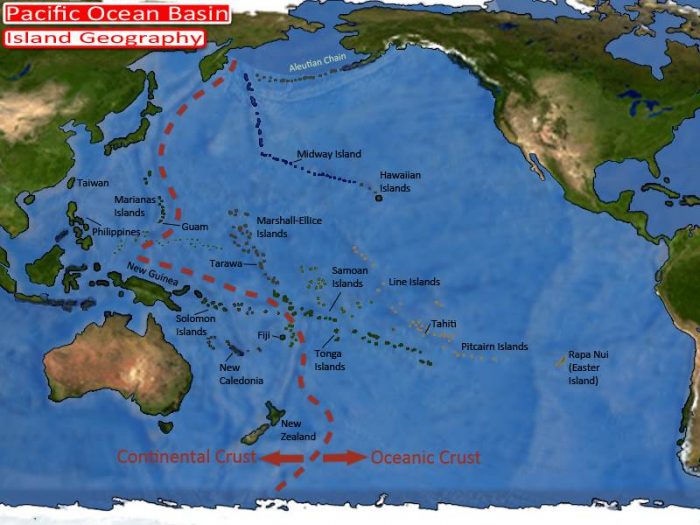
Photo: By MTBlack – Own work, CC BY-SA 3.0, https://commons.wikimedia.org/w/index.php?curid=27235864
The Pacific Ocean is the largest out of all five of the oceans, running between the western coast of the two American continents and the Eastern portion of Australia and Asia. At the north and south ends of the Pacific Ocean, the Arctic and Antarctic regions border it. There are many tropical islands within the Pacific Ocean, most of which found in East Asia, and because of this the Pacific Ocean also has the longest shoreline out of all the oceans, with some 84,000 (or 135,000 km) of shoreline. Estimates of the number of islands in the Pacific Ocean put the number of islands at about 25,000 with the three main island groups being Polynesia, Micronesia, and Melanesia.
The Pacific Ocean is also home to the deepest point on earth, the Challenger Deep located in the Marianas Trench. This is the portion of the seafloor around 11,000 m below sea level, first discovered by the HMS challenger in 1875. At over 11,000 m or 7 miles below sea level, it was long assumed that lifeforms could not exist at the extreme water pressure and depth of the Challenger Deep. Yet research carried out since has found that there are many different species of flatworms, shrimp, and protists living within the deep.
The Pacific Ocean is home to the ring of fire, a horseshoe-shaped ring of hundreds of active volcanoes. Around three-quarters of the world’s active volcanoes are located in this region. The Pacific Ocean is also home to the Great Barrier reef, the longest reef in the world, found off of the coast of Australia. Notable islands in the Pacific ocean include the Galapagos Islands, Easter Island, and New Guinea. New Guinea is the second largest island in the world after Greenland while the Galapagos Islands are found in the southeast Pacific and are home to a vast variety of wildlife.
The Pacific Ocean gained its name from the explorer Ferdinand Magellan, in 1520, when he explored the southernmost tip of South America Hoping to find a westerly passage to the Spice Islands. The Strait of Magellan lead him to the Pacific Ocean, which he described as being particularly beautiful and peaceful (“pacific” meaning peaceful).
Atlantic Ocean
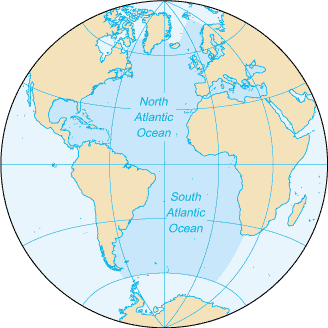
Photo: By CIA – CIA World Factbook – Atlantic Ocean (picture URL), Public Domain, https://commons.wikimedia.org/w/index.php?curid=7627352
After the Pacific Ocean, the Atlantic Ocean has the largest area. The area of the Atlantic Ocean is around 41,080,000 mi.² or 106,400,000 km². The Atlantic Ocean is bordered by the Western shores of Africa and Europe to the east and the eastern shores of the American continents to the West. The Atlantic Ocean also includes smaller sea is like the Gulf of Mexico, the Baltic Sea is, the Caribbean sea, and the Mediterranean sea. Much like the Pacific Ocean, the Atlantic Ocean stretches from the Arctic region to the Antarctic region.
The Atlantic Ocean was charted quite thoroughly over the course of centuries with the 15th century seeing a substantial amount of charting, and along with the Indian Ocean European travelers believed it to be the total expanse of the known world.
The Atlantic ocean was once home to vast populations of sperm whale and cod, though populations of these sea creatures have dwindled over the years as hunting and fishing have placed extreme pressures on these animals. Cod has long been an important food source for human populations, most notably European settlers during the settling of colonies across North America, who finished for cod heavily due to the cards easily preserved flesh. The largest living mammal is the sperm whale, and whalers in the late 18th and early 19th centuries hunted the sperm whale nearly to extinction seeking to harvest its stores of fat and oil, which were used to create lamps for North American and European populations.
The warm Gulf stream and the Atlantic Ocean means that ports in northern Europe are usually kept free of ice. The Atlantic Ocean is home to an underwater mountain range called the Atlantic Ridge, found within the North Atlantic Ocean and running approximately 10,000 miles (16,100 km) from Iceland. The Atlantic Ridge is twice as wide as the Andes mountain range. The Atlantic Ocean is also where the second largest barrier reef in the world is found. This reef is the Cancun reef, and it is located off of the Eastern coast of Mexico.
Indian Ocean
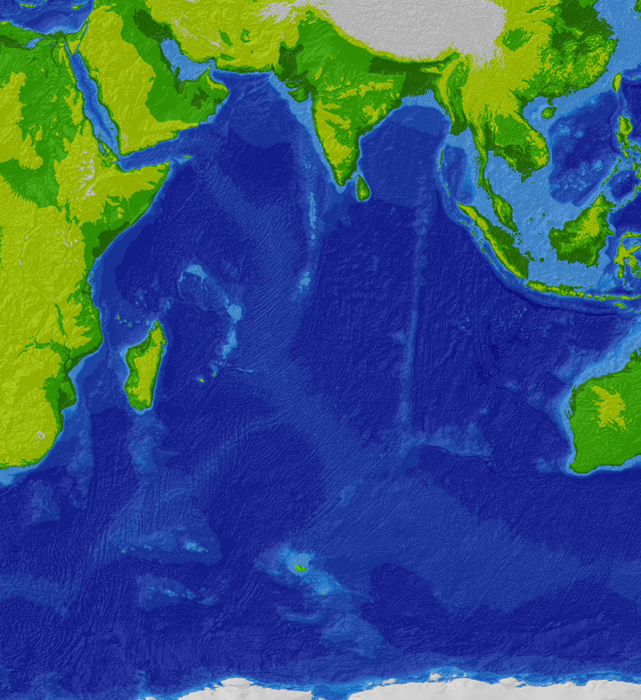
Photo: CC BY-SA 3.0, https://commons.wikimedia.org/w/index.php?curid=74716
The Indian Ocean covers the regions between Africa’s eastern coast, India and the Middle East, Southeast Asia, and Oceania/Australia. This area is approximately 28,400,130 sq mile (73,556,000 km²) in size. The Indian ocean is home to a large diversity of life, with various species of aquatic animals and plants. The Indian Ocean also has a long history with humanity, with diverse groups of populations exploring it and settling in areas around it. Regions bordering the Indian Ocean cultivate many spices like nutmeg, ginger, and black pepper, used to flavor cuisines all around the world. The Spice Islands can be found in the Indian Ocean, and many battles and wars were fought over the islands, attempting to gain control over them and the valuable spices grown there.
The Indian Ocean has rather limited Marine life compared to the other oceans of the world, due in part to its temperature. The temperature of the Indian Ocean means that phytoplankton have difficulty growing in it, and phytoplankton is the base of the food chain for much of the ocean. The primary access points to the Indian Ocean are the Bab el Mandeb in Djibouti-Yemen, the Strait of Malacca in Malaysia or Indonesia, the Suez Canal in Egypt, and the Strait of Hormuz in Iran-Oman. The Indian Ocean is where much of the world’s oil comes from, with an estimated 40% of oil pulled from it. The Kerguelen Plateau is a massive region that gives birth to many volcanoes, and it lies beneath the southern Indian Ocean.
Arctic Ocean
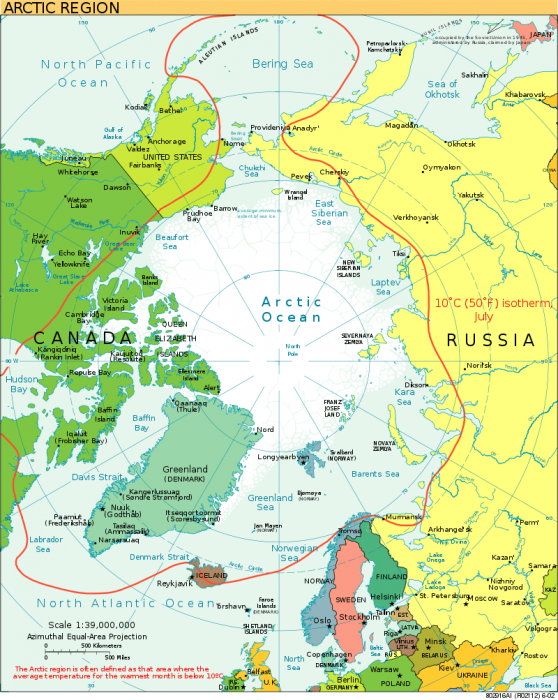
Photo: By CIA World Factbook – CIA World Factbook, Public Domain, https://commons.wikimedia.org/w/index.php?curid=531491
The Arctic Ocean in the smallest of all oceans, and it is also the shallowest. Most of the Arctic Ocean is found within the Arctic Circle, and it occupies an area of approximately 5,400,000 mi.² large or 13,980,000 km large. The Arctic Ocean includes smaller seas like the North Sea, the Hudson Bay, and the Bering Sea. Because the Arctic Ocean is so far North, much of the ocean is choked with large ice deposits hundreds of feet thick for most of the year. Large portions of the Arctic Ocean can be impassable even during the summer. Despite the large stretches of ice, cold, and generally inhospitable conditions, the region surrounding the Arctic Ocean have been inhabited since antiquity by ancestors of populations in Scandinavia, Russia, and North America, groups of people like the Inuit and the Sami.
Through the 16th to 19th centuries, explorers looked for the Northwest Passage, a hypothetical passage that would link the North Atlantic to Asia, facilitating easier trade of the silks, spices, and opium. While the vast majority of the expeditions to find the Northwest passage ended in failure, during the 19th and 20th centuries progress through the Arctic Ocean to the two other oceans could finally be made.
Pack ice is that the ice found at the edge of the polar ice (the ice surrounding the poles themselves). This pack ice freezes solid in the winter. Beyond pack ice and polar ice, the Arctic Ocean also experiences fast ice, ice which forms briefly during the winter around pack ice and near the coast of land surrounding the Arctic Ocean.
At least six seal species can be found living in the Arctic Ocean included in the spotted seal, the hooded seal, the harp seal, ring seal, the ribbon seal, and the bearded seal. Additionally, at least four whale species can also be found there including the gray whale, the bowhead whale, the Beluga whale, and the narwhal.
Southern Ocean
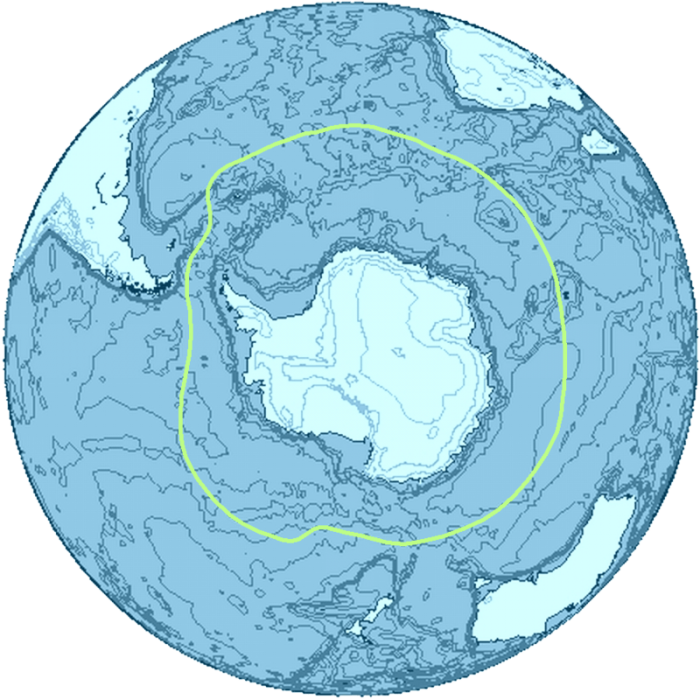
Photo: By Apcbg – Own work, CC BY-SA 3.0, https://commons.wikimedia.org/w/index.php?curid=6093734
Prior to the year 2000, the stretches of ocean surrounding Antarctica were considered extensions of the neighboring oceans, the Pacific Ocean, the Indian ocean, and the Atlantic Ocean. However, members of the International Hydrographic Organization agreed to regard the waters surrounding Antarctica as the Southern Ocean in 2000. While the Southern Ocean doesn’t have exact boundaries determined yet, regions of ocean below 60° South latitude are usually considered part of the Southern Ocean, giving the southern ocean an area of approximately 7, 848,000 square miles or 20, 327,000 km². The Southern Ocean links the Indian, Pacific, and Atlantic oceans together through a constant easterly current, and therefore while smaller than the other oceans it has a supreme impact on the weather patterns of the earth.
The largest penguin species in the world, the Emperor Penguin, can be found on the continent of Antarctica and on the massive ice chunks found throughout the Southern Ocean. Antarctica is home to approximately 90% of the ice on the planet. Various treaties restrict military activity in the Southern Ocean, with scientific research being permitted. The Southern Ocean’s average depth is approximately 13,100 to 16,400 feet deep.









